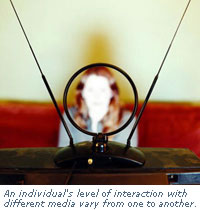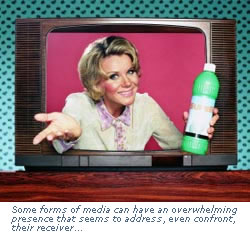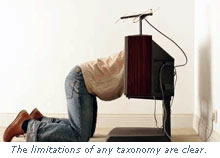Interlocked Circles of the Senses: A New Taxonomy of
Media
Fig. 1, Fig. 2
The accompanying spread sheet explicitly maps out the specific criteria used in order to classify each medium beyond (more specifically) the visual-auditory-tactile schema of the illustrated diagram. In choosing the three senses as the overriding rubric, I intended to underscore the fact that it is through/by way of our senses that we perceive and receive different forms of media. As the medium of film employs images and sound, we perceive the film with our senses of sight and hearing; thus, the vocabulary of media speaks directly to the human sensorium.
In choosing the three senses as the overriding rubric, I intended to underscore the fact that it is through/by way of our senses that we perceive and receive different forms of media. As the medium of film employs images and sound, we perceive the film with our senses of sight and hearing; thus, the vocabulary of media speaks directly to the human sensorium.
In starting the spread sheet classification with the sender-receiver binary, I drew upon the foundational definition of 'medium' found in the OED as, "something which is intermediate between two degrees, amounts, qualities, or classes; a middle state." The sender and receiver are the two degrees, while the medium is the third term between them. Thus, I thought it would be best to begin with this distinction for each medium. The selected twenty media—on the vertical axis—are intended to offer a wide range of what are considered to be 'media,' spanning from the assumed (e.g. cinema and writing) to the less expected (e.g. Braille and the music video). The criteria on the horizontal axis progress from concrete concepts that refer to space and the material, to more abstract typings, such as 'Degree of Complexity'. The range of these criteria is meant to speak to materiality of the media as well as their (social/communicative) roles in affecting change.
 Some explanation of the criteria terminology seems to be in order: 'Scale' refers to the medium's size in relation to it surroundings (on a scale of small, medium and large ); 'Interaction' refers to the standard level of involvement that is necessary (in order for the medium to be effective) between the medium and the receiver—who can be either passive (the level of interaction in this case would be 'low'), actively engaged ('high'), or sporadic ('mid-level'); 'Expression/Experience of medium' speaks to the manner in which it is presented, how it is intended to be received; it could be either continuous (e.g. most films seen at movie theaters), punctuated (by commercials, as in the case with television), intermittent (e.g. a piece of art work or literature that promotes further reflection) or indeterminate (it can be continuous, punctuated or intermittent, for there is really no standard way of reading a book, no number of pages read that is considered 'typical' of the practice of reading a book, while a movie is—in general—intended to be viewed in its entirety in one sitting).
Some explanation of the criteria terminology seems to be in order: 'Scale' refers to the medium's size in relation to it surroundings (on a scale of small, medium and large ); 'Interaction' refers to the standard level of involvement that is necessary (in order for the medium to be effective) between the medium and the receiver—who can be either passive (the level of interaction in this case would be 'low'), actively engaged ('high'), or sporadic ('mid-level'); 'Expression/Experience of medium' speaks to the manner in which it is presented, how it is intended to be received; it could be either continuous (e.g. most films seen at movie theaters), punctuated (by commercials, as in the case with television), intermittent (e.g. a piece of art work or literature that promotes further reflection) or indeterminate (it can be continuous, punctuated or intermittent, for there is really no standard way of reading a book, no number of pages read that is considered 'typical' of the practice of reading a book, while a movie is—in general—intended to be viewed in its entirety in one sitting).
 'Affect' speaks to the overall impression that the media give off. Admittedly, this is a highly subjective quality, particularly in cases of artistic media such as film or writing where I had to make crude generalizations. However I wanted to make sure to point out the distinction between media that are, meant to be seen, noticed, or noted, and those that are not. The distinction of 'affect' can be at the two polar extremes of 'indistinct' or 'overwhelming,' or somewhere in the middle as 'average' (the Internet, for example, is ranked as 'indistinct' because it is becoming common place, while a performance of Shakespeare still moves people as an 'event.' Degree of Complexity' (DOC) refers, most explicitly, to the attention span required to consume a particular medium; what is considered to have a 'low' DOC is fragmented; that with a 'high' DOC is linear and sequential; and finally, 'Context' refers to the so-called intention or 'function' of the medium (e.g. entertainment, discipline, communication, aesthetic, functional).
'Affect' speaks to the overall impression that the media give off. Admittedly, this is a highly subjective quality, particularly in cases of artistic media such as film or writing where I had to make crude generalizations. However I wanted to make sure to point out the distinction between media that are, meant to be seen, noticed, or noted, and those that are not. The distinction of 'affect' can be at the two polar extremes of 'indistinct' or 'overwhelming,' or somewhere in the middle as 'average' (the Internet, for example, is ranked as 'indistinct' because it is becoming common place, while a performance of Shakespeare still moves people as an 'event.' Degree of Complexity' (DOC) refers, most explicitly, to the attention span required to consume a particular medium; what is considered to have a 'low' DOC is fragmented; that with a 'high' DOC is linear and sequential; and finally, 'Context' refers to the so-called intention or 'function' of the medium (e.g. entertainment, discipline, communication, aesthetic, functional).
While there was repetition in the chosen categorizing terms, the distinctions were often less than adequate; for example, though the term 'audience' was designated as the receiver for both theater and music video, these audiences are not likely to overlap in demographics). Thus, the limitations of any taxonomy are clear, for no matter how hard one tries to broaden or specify the applied parameters, it is inevitable that particular media will complicate and dismantle them.
 In no way do I propose that this model of a media taxonomy is comprehensive or absolute; it is undeniably, as well as inevitably, reductionist as well as subjective in its views and methods. Ultimately, as an abstraction or codification of my personal tendencies, perceptions and internalized conventions, what is seen above is simply meant to make explicit my own tacit ideas, particularly those that seem altogether manifest. Though the impossibility of this task to effectively schematize media will most likely loom above our heads for all time, it is only by delving into the seemingly impenetrable maelstrom of media taxonomy that we can hope to further promote new and enlightening discussion that will hopefully lead to valuable insight.
In no way do I propose that this model of a media taxonomy is comprehensive or absolute; it is undeniably, as well as inevitably, reductionist as well as subjective in its views and methods. Ultimately, as an abstraction or codification of my personal tendencies, perceptions and internalized conventions, what is seen above is simply meant to make explicit my own tacit ideas, particularly those that seem altogether manifest. Though the impossibility of this task to effectively schematize media will most likely loom above our heads for all time, it is only by delving into the seemingly impenetrable maelstrom of media taxonomy that we can hope to further promote new and enlightening discussion that will hopefully lead to valuable insight.
Kasia Houlihan
Winter 2004
Fig. 1, Fig. 2
The accompanying spread sheet explicitly maps out the specific criteria used in order to classify each medium beyond (more specifically) the visual-auditory-tactile schema of the illustrated diagram.
 In choosing the three senses as the overriding rubric, I intended to underscore the fact that it is through/by way of our senses that we perceive and receive different forms of media. As the medium of film employs images and sound, we perceive the film with our senses of sight and hearing; thus, the vocabulary of media speaks directly to the human sensorium.
In choosing the three senses as the overriding rubric, I intended to underscore the fact that it is through/by way of our senses that we perceive and receive different forms of media. As the medium of film employs images and sound, we perceive the film with our senses of sight and hearing; thus, the vocabulary of media speaks directly to the human sensorium. In starting the spread sheet classification with the sender-receiver binary, I drew upon the foundational definition of 'medium' found in the OED as, "something which is intermediate between two degrees, amounts, qualities, or classes; a middle state." The sender and receiver are the two degrees, while the medium is the third term between them. Thus, I thought it would be best to begin with this distinction for each medium. The selected twenty media—on the vertical axis—are intended to offer a wide range of what are considered to be 'media,' spanning from the assumed (e.g. cinema and writing) to the less expected (e.g. Braille and the music video). The criteria on the horizontal axis progress from concrete concepts that refer to space and the material, to more abstract typings, such as 'Degree of Complexity'. The range of these criteria is meant to speak to materiality of the media as well as their (social/communicative) roles in affecting change.
 Some explanation of the criteria terminology seems to be in order: 'Scale' refers to the medium's size in relation to it surroundings (on a scale of small, medium and large ); 'Interaction' refers to the standard level of involvement that is necessary (in order for the medium to be effective) between the medium and the receiver—who can be either passive (the level of interaction in this case would be 'low'), actively engaged ('high'), or sporadic ('mid-level'); 'Expression/Experience of medium' speaks to the manner in which it is presented, how it is intended to be received; it could be either continuous (e.g. most films seen at movie theaters), punctuated (by commercials, as in the case with television), intermittent (e.g. a piece of art work or literature that promotes further reflection) or indeterminate (it can be continuous, punctuated or intermittent, for there is really no standard way of reading a book, no number of pages read that is considered 'typical' of the practice of reading a book, while a movie is—in general—intended to be viewed in its entirety in one sitting).
Some explanation of the criteria terminology seems to be in order: 'Scale' refers to the medium's size in relation to it surroundings (on a scale of small, medium and large ); 'Interaction' refers to the standard level of involvement that is necessary (in order for the medium to be effective) between the medium and the receiver—who can be either passive (the level of interaction in this case would be 'low'), actively engaged ('high'), or sporadic ('mid-level'); 'Expression/Experience of medium' speaks to the manner in which it is presented, how it is intended to be received; it could be either continuous (e.g. most films seen at movie theaters), punctuated (by commercials, as in the case with television), intermittent (e.g. a piece of art work or literature that promotes further reflection) or indeterminate (it can be continuous, punctuated or intermittent, for there is really no standard way of reading a book, no number of pages read that is considered 'typical' of the practice of reading a book, while a movie is—in general—intended to be viewed in its entirety in one sitting). 'Affect' speaks to the overall impression that the media give off. Admittedly, this is a highly subjective quality, particularly in cases of artistic media such as film or writing where I had to make crude generalizations. However I wanted to make sure to point out the distinction between media that are, meant to be seen, noticed, or noted, and those that are not. The distinction of 'affect' can be at the two polar extremes of 'indistinct' or 'overwhelming,' or somewhere in the middle as 'average' (the Internet, for example, is ranked as 'indistinct' because it is becoming common place, while a performance of Shakespeare still moves people as an 'event.' Degree of Complexity' (DOC) refers, most explicitly, to the attention span required to consume a particular medium; what is considered to have a 'low' DOC is fragmented; that with a 'high' DOC is linear and sequential; and finally, 'Context' refers to the so-called intention or 'function' of the medium (e.g. entertainment, discipline, communication, aesthetic, functional).
'Affect' speaks to the overall impression that the media give off. Admittedly, this is a highly subjective quality, particularly in cases of artistic media such as film or writing where I had to make crude generalizations. However I wanted to make sure to point out the distinction between media that are, meant to be seen, noticed, or noted, and those that are not. The distinction of 'affect' can be at the two polar extremes of 'indistinct' or 'overwhelming,' or somewhere in the middle as 'average' (the Internet, for example, is ranked as 'indistinct' because it is becoming common place, while a performance of Shakespeare still moves people as an 'event.' Degree of Complexity' (DOC) refers, most explicitly, to the attention span required to consume a particular medium; what is considered to have a 'low' DOC is fragmented; that with a 'high' DOC is linear and sequential; and finally, 'Context' refers to the so-called intention or 'function' of the medium (e.g. entertainment, discipline, communication, aesthetic, functional). While there was repetition in the chosen categorizing terms, the distinctions were often less than adequate; for example, though the term 'audience' was designated as the receiver for both theater and music video, these audiences are not likely to overlap in demographics). Thus, the limitations of any taxonomy are clear, for no matter how hard one tries to broaden or specify the applied parameters, it is inevitable that particular media will complicate and dismantle them.
 In no way do I propose that this model of a media taxonomy is comprehensive or absolute; it is undeniably, as well as inevitably, reductionist as well as subjective in its views and methods. Ultimately, as an abstraction or codification of my personal tendencies, perceptions and internalized conventions, what is seen above is simply meant to make explicit my own tacit ideas, particularly those that seem altogether manifest. Though the impossibility of this task to effectively schematize media will most likely loom above our heads for all time, it is only by delving into the seemingly impenetrable maelstrom of media taxonomy that we can hope to further promote new and enlightening discussion that will hopefully lead to valuable insight.
In no way do I propose that this model of a media taxonomy is comprehensive or absolute; it is undeniably, as well as inevitably, reductionist as well as subjective in its views and methods. Ultimately, as an abstraction or codification of my personal tendencies, perceptions and internalized conventions, what is seen above is simply meant to make explicit my own tacit ideas, particularly those that seem altogether manifest. Though the impossibility of this task to effectively schematize media will most likely loom above our heads for all time, it is only by delving into the seemingly impenetrable maelstrom of media taxonomy that we can hope to further promote new and enlightening discussion that will hopefully lead to valuable insight. Kasia Houlihan
Winter 2004